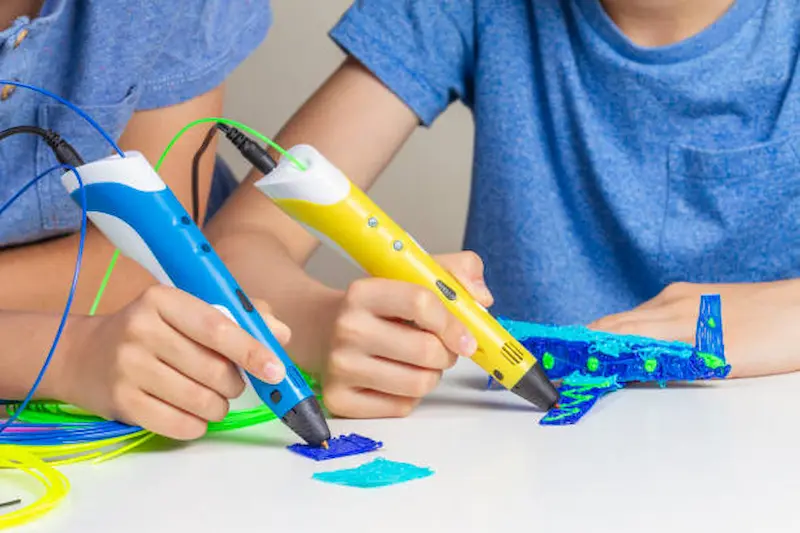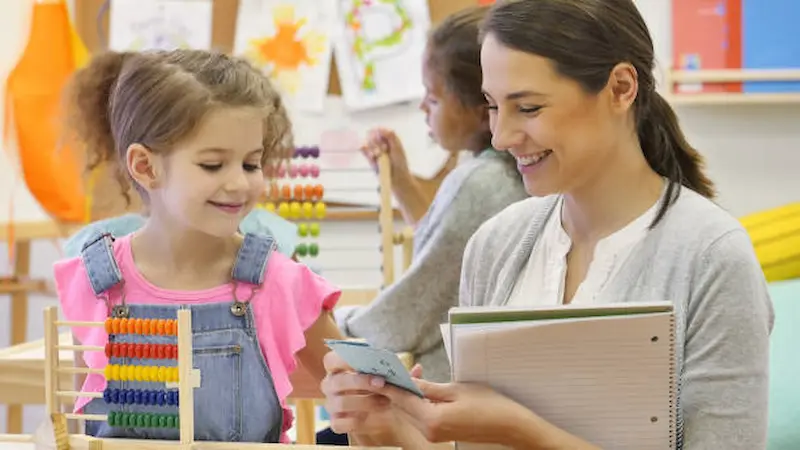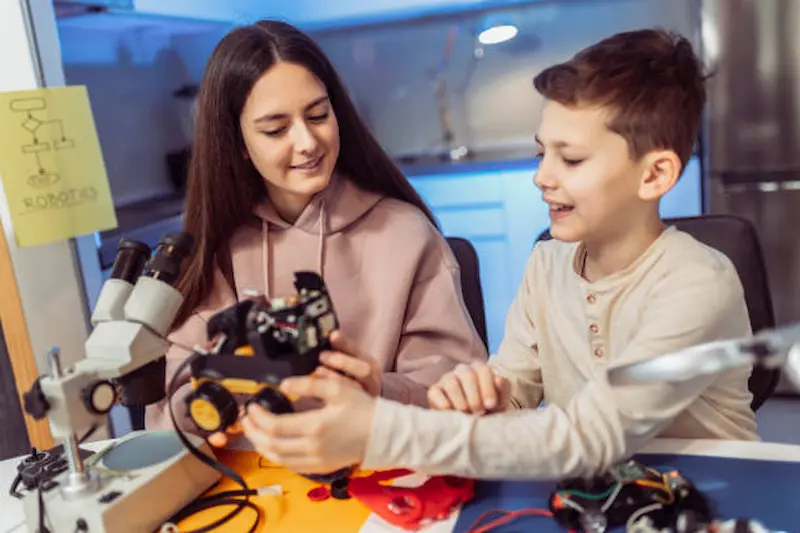Robotics education in kindergarten sparks young minds’ curiosity and creativity. Introducing robotics education in kindergarten sparks early interest in STEM fields and nurtures problem-solving and critical-thinking skills. Robotic Projects for Kindergarten cultivate a foundation for future technological literacy, equipping young learners with valuable skills for an increasingly automated world. The MECE (Mutually Exclusive, Collectively Exhaustive) framework is a structured problem-solving approach used in various fields, such as consulting and project management.
In this blog, we’ll explore the valuable benefits of introducing robotics education in kindergarten. Early exposure to robotics fosters critical thinking, and problem-solving skills, and ignites a passion for STEM subjects, setting the stage for a future generation of innovative thinkers and creators.
Table of contents
- Bristlebot Projects
- Brush Bot Creations
- Paper Plate Robots
- Balloon-Powered Cars
- Tinfoil Boat Adventures
- Cork Robot Friends
- Scribble Bot Art
- LEGO WeDo 2.0 Exploration
- Dance Party Robots
- Benefits of Robotic Projects in Kindergarten
- Safety Considerations for Kindergarten Robotics
- Conclusion
- Frequently Asked Questions ( FAQs )
Bristlebot Projects

A. What is a Bristlebot?
A Bristlebot is a simple and fun DIY robot made from basic materials. It typically consists of a toothbrush head (the bristles), a small vibrating motor, and a battery. When assembled, the vibration causes the Bristlebot to move in unpredictable ways, making it an engaging educational tool for exploring robotics and basic engineering principles.
B. Materials Needed
To create a Bristlebot, you’ll require a toothbrush head, a small vibrating motor (commonly found in old cell phones or purchased from hobby stores), a coin cell battery, double-sided tape, and some basic tools for assembly.
C. Step-by-Step Instructions
Follow these steps to build your Bristlebot:
- Attach the motor to the toothbrush head using double-sided tape.
- Connect the motor wires to the battery to power the Bristlebot.
- Place it on a flat surface and watch it move!
D. Learning Outcomes
Bristlebot projects, designed to enhance leadership skills for kids, teach students fundamental concepts of engineering, circuitry, and robotics. They encourage problem-solving and creativity, as students can customize their Bristlebots, fostering leadership qualities like initiative and innovation. Additionally, these projects promote an understanding of motion, balance, and scientific principles, making them an engaging way to introduce STEM concepts in educational settings while nurturing leadership skills in young learners.
Brush Bot Creations

A. Building a Brush Bot
Creating a Brush Bot is a hands-on project involving basic materials like a toothbrush, a small vibrating motor, and a power source. The construction process typically includes attaching the motor to the toothbrush and connecting it to a battery or power supply. It’s an excellent way for students to explore engineering and robotics concepts while practicing their problem-solving skills.
B. Decorating Your Brush Bot
Encourage creativity by allowing students to personalize their Brush Bots. They can use art supplies like googly eyes, colorful markers, or pipe cleaners to give their robots unique appearances.
This not only enhances the fun but also brings an artistic element to the project.
C. Observing Brush Bot Movements
Once constructed and decorated, students can observe the movements of their Brush Bots. These simple robots move forward or vibrate in place, offering a chance to discuss basic physics principles and introduce concepts like balance, friction, and motion. It’s a hands-on way to engage students in science and technology.
Paper Plate Robots

A. Crafting Paper Plate Robots
Creating paper plate robots is a delightful arts and crafts project suitable for kids, offering an avenue for creativity and crafts for kids. To make one, children need a paper plate, markers, scissors, and craft materials. They can draw a robot face on the plate and cut out holes for the arms and legs, honing fine motor skills and allowing their imagination to run wild in the process.
B. Adding Wheels and Decorations
To bring their paper plate robots to life, kids can add wheels using bottle caps or colorful construction paper, engaging in a creative process that’s akin to coloring pages for kids.
They can also decorate their robots with buttons, pipe cleaners, or any imaginative items they desire, further fostering individuality and design skills while making their robots uniquely their own.
C. Rolling and Playing with Paper Plate Robots
Once completed, children can roll their paper plate robots around, engage in imaginative play, and even create robot-themed stories or activities for kids. This hands-on project encourages storytelling, imaginative play, and fine-tunes gross and fine motor skills, making it an enjoyable and educational experience for kids.
Balloon-Powered Cars
Balloon-powered cars are an exciting STEM project for kids that teaches the principles of propulsion and aerodynamics. To create one, children attach a balloon to a small car chassis, securing it with tape or a rubber band. When they release the air from the balloon, the escaping air propels the car forward. This engaging activity introduces concepts of energy transfer and engineering, making it a fun way to explore basic physics principles.
Tinfoil Boat Adventures

Tinfoil boat experiments captivate young learners by combining science and creativity. Children design and construct boats using tinfoil, exploring principles of buoyancy and water displacement. They experiment with different shapes and sizes, hypothesize outcomes, and test their boats’ capacity to stay afloat. This hands-on activity not only introduces fundamental concepts of physics and engineering but also encourages critical thinking and problem-solving skills, making it a captivating and educational adventure for kids.
Cork Robot Friends
Cork robots, a popular DIY project in the world of robotics for kids, offer an engaging way to teach young learners about recycling and engineering. Children can construct their own robot friends by repurposing old wine corks, fostering creativity and environmental consciousness.
This hands-on activity encourages motor skills development and introduces basic engineering principles, making it a fun and educational experience. Plus, the adorable cork robots make for unique, eco-friendly companions that kids can proudly display or play with, merging fun, learning, and sustainability.
Scribble Bot Art
Scribble bots are fantastic tools for introducing young learners to the intersection of art and technology. These simple, vibrating robots equipped with markers create mesmerizing, abstract drawings. Engaging in the construction and operation of scribble bots not only teaches kids about basic mechanics but also encourages artistic expression. This interdisciplinary approach fosters creativity, problem-solving skills, and an early appreciation for the fusion of science and art in a playful, hands-on manner.
LEGO WeDo 2.0 Exploration

LEGO WeDo 2.0 offers an immersive educational experience, combining building with robotics and programming in LEGO robotics for kids. Geared towards elementary students, it allows them to construct various models and control them using a user-friendly interface. Through hands-on experimentation, children learn about engineering, coding, and problem-solving, fostering essential skills for the digital age. The system includes lesson plans that align with STEM education standards, making it a valuable tool for educators and an exciting learning platform for young students.
Dance Party Robots
Dance party robots are a delightful way to introduce kindergarteners to robotics and music while instilling good habits for kids. These small, programmable robots can groove to the beats, helping children learn programming basics through fun and interactive experiences. Dancing robots foster coordination, rhythm, and social skills when kids dance along. Moreover, they ignite a passion for STEM through an entertaining medium, setting the stage for a future generation of tech-savvy, creative thinkers who can code and dance their way to innovation.
Benefits of Robotic Projects in Kindergarten

A. Cognitive Development
Robotic projects in kindergarten, designed to promote child cognitive development, offer substantial opportunities for intellectual growth. By engaging in these hands-on activities, young learners enhance their understanding of cause-and-effect relationships, improving their logical thinking. As they troubleshoot and refine their robots, they also develop essential spatial awareness and spatial reasoning skills, which are foundational for future math and science learning.
B. Problem-Solving Skills
Kindergarten robotics projects, including those designed for critical thinking skills for kids, encourage problem-solving from a young age. Children learn to identify issues, experiment with solutions, and adapt their designs based on trial and error. This iterative problem-solving process builds resilience and persistence, essential qualities for tackling challenges throughout their education and beyond.
C. Fostering Creativity
Robotic projects, including robotics projects for kids, ignite creativity in children. Through designing, decorating, and customizing their robots, kindergarteners and young learners explore their imagination.
This imaginative freedom not only fuels artistic expression but also sparks innovative thinking. These creative skills provide a solid foundation for future innovation, empowering students to approach complex problems with innovative solutions.
Safety Considerations for Kindergarten Robotics
Safety is paramount when introducing robotics to kindergarteners or in robotics classes for kids. Ensure age-appropriate robot designs with no small, swallowable parts to prevent choking hazards. Choose materials that are non-toxic and easy to handle. Supervision during robot construction and operation is essential to prevent accidents. Prioritize fire safety if using batteries and teach children to be mindful of electrical components. By addressing these considerations, you create a secure environment for introducing technology to young learners, fostering a positive and safe early robotics experience.
Conclusion
Robotic Projects for Kindergarten involve age-appropriate, hands-on activities that introduce young children to basic robotics concepts. These projects often include designing and building simple robots or exploring pre-made robots with engaging tasks. The benefits include fostering early STEM interest, developing problem-solving skills, encouraging creativity, and promoting teamwork, setting a strong foundation for lifelong learning and innovative thinking in the digital age.
To get your hands on more educational and free resources on coding for kids, robotics for kids, financial education for kids, etc., do check out the BrightCHAMPS Page now!
To get your hands on more such articles, educational content, and free resources on coding for kids, robotics courses, game development, etc., check out the BrightCHAMPS Blog Page now!
Frequently Asked Questions ( FAQs )
A1. The ideal age to introduce robotics to kindergartners is around 5 to 6 years old, as they begin to develop basic problem-solving and fine motor skills.
Q2. How can parents support robotics education at home?
A2. Parents can support robotics education at home by providing access to age-appropriate robotics kits, encouraging hands-on exploration, and seeking online resources and tutorials.
Q3. Are there any affordable robotics kits for kindergartners?
A3. Yes, there are affordable robotics kits designed for kindergartners, such as the Bee-Bot or Cubetto, which offer a great starting point for young learners.
Q4. What are some advanced robotic projects for older kids?
A4. Older kids can delve into advanced robotic projects like building programmable robots, creating automation systems, or exploring artificial intelligence concepts using platforms like LEGO Mindstorms or Arduino.


 We are an army of educators and passionate learners from BrightChamps family, committed to providing free learning resources to kids, parents & students.
We are an army of educators and passionate learners from BrightChamps family, committed to providing free learning resources to kids, parents & students.








